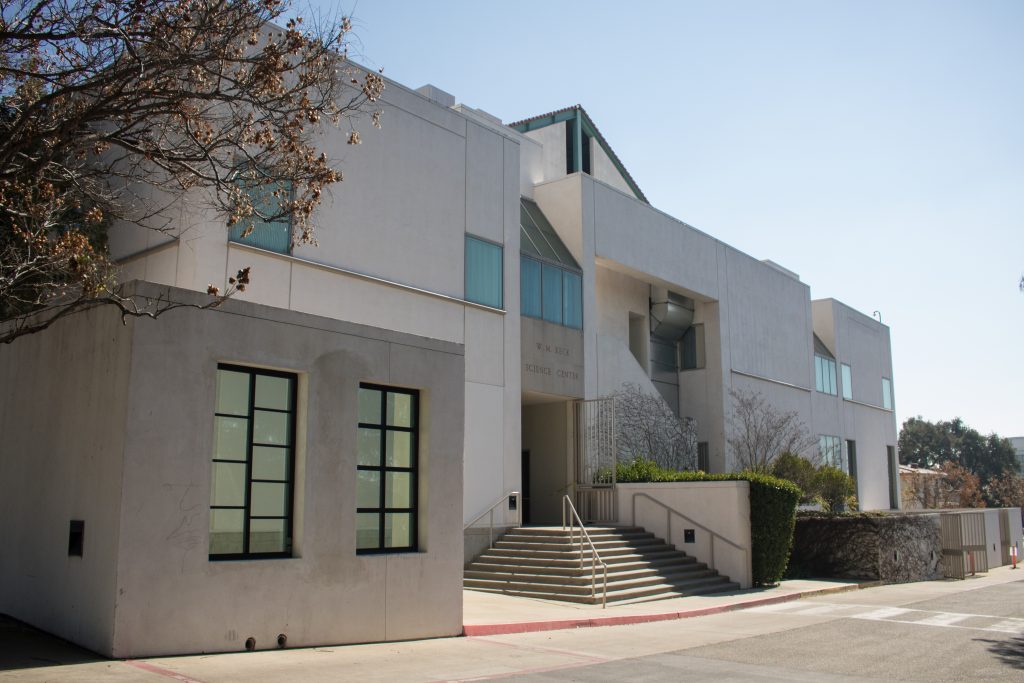Amelie Lee ’23
Copy Editor
Keck Science Center is getting a fresh new look, requiring the temporary relocation of resources and animals.
The renovation process has limited storage space in Keck, leading to reports of lab animals being stored in unorthodox locations on campus, including the Dorothy Drake Wing of Scripps’ Ella Strong Denison Library. Staff members working at Denison confirmed that lab animals were moved into the wing two to three weeks ago. When asked about the safety and sterility of the animals, Biology professor Jenna Monroy reiterated that proper measures have been taken to ensure safety. Outside students not involved with animal research are not permitted to see the wing.
“The care and use of animals in research is highly regulated and must be approved by an Institutional Animal Care and Use Committee.” Monroy said. “The space that the animals are currently housed in was completely remodeled to match all the requirements necessary for housing research animals. Many of the research animals are pathogen-free, that is they carry no viruses or bacteria that can cause disease.”
Jess Maurice ’22, a Scripps College neuroscience major who recently worked with mice in Denison for research on effects of exercise on performance and muscle physiology in mice, provided comment on the temporary changes.
“The whole area was converted to accommodate a sterile research lab, so I and the people I’m working in the lab with are okay with [the move],” Maurice said.
Dean of the Keck Science Department Ulysses J. Sofia reported that some resources may be moved for constructions but provided no comment on reports of live animals on campus.
Theodora Helgason ’22, a staffer on TSV, reported seeing a dead rat on the floor near the matriculation doors of Denison Sunday evening while with friends. Keck staff denies that this particular animal has any correlation with the relocated lab animals, as animal facilities currently do not consist of rats.
Denison librarian Jennifer Martinez Wormser confirmed the dead rat but supported its lack of connection to the lab animals in Denison. “I saw a large, dead rat in front of the Denison double doors this morning when I arrived on campus. I notified Scripps Facilities, who took care of its disposal. I do not believe it has anything to do with the vivarium,” Wormser said.
Over the next two years the Keck building will continue to undergo renovation while continuing to hold classes in the building. The planned changes to the existing Keck building include three levels, two of which will be completed by Fall 2022 and a third that will be constructed at a later date. Infrastructure updates include teaching labs, a few offices as well as study spaces for Claremont students.
Much of the building’s renovation is focused on redesigning classrooms to accommodate Claremont McKenna’s planned departure from Keck. As the schools anticipate reducing Keck’s student population by a third, construction includes reducing classroom sizes and modernizing the current structure of the labs. Josh Reeder, Executive Director of Facilities Management and Auxiliary Operations, is overlooking the process of renovation.
“The main difference will be a more modern and current application for labs used in today’s cutting edge science programs, as opposed to the 30-year-old existing Keck technology,” Reeder said. “This includes improved hoods for lab safety, audio visual elements, and energy-efficient lighting and infrastructure.”
Renovation will affect parking on the Claremont campuses, specifically between Scripps College and Pitzer College. In the next few months, students can expect construction to the Revelle parking lot on 9th and Mills Street.
“As we get closer to construction, we will be able to send out more specific communications regarding the specifics of the parking impacts for all students, faculty, and staff,” Reeder said.
While the temporary animal relocation in Denison seems to have the most significant effect of construction, the Scripps community has seemed unfazed. All resources and animals should return to the Keck Science Center at the conclusion of Keck’s renovation.
A prior version of this article misidentified the lab animals in Denison as rats. The animals involved with Keck lab research are mice, not rats. The spelling of Professor Monroy’s name has also been corrected. We take full responsibility for these inaccuracies and any misrepresentation of Keck research perpetuated by mistaken association between the lab animals currently in Denison and the dead rat found outside Denison. These errors do not reflect the journalistic standard of The Voice and we apologize.
Image Credit: Alyssa Leong ’23



